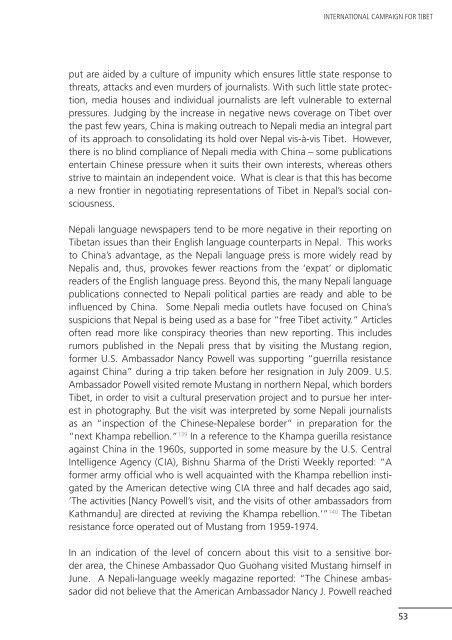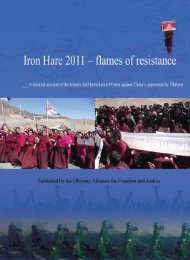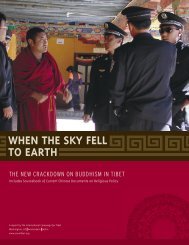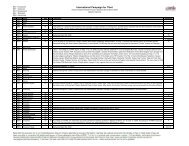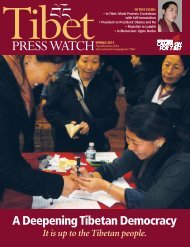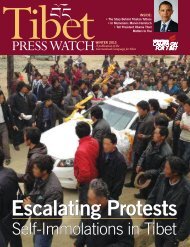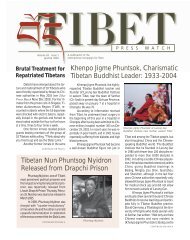DANGEROUS CROSSING: - International Campaign for Tibet
DANGEROUS CROSSING: - International Campaign for Tibet
DANGEROUS CROSSING: - International Campaign for Tibet
Create successful ePaper yourself
Turn your PDF publications into a flip-book with our unique Google optimized e-Paper software.
INTERNATIONAL CAMPAIGN FOR TIBET<br />
put are aided by a culture of impunity which ensures little state response to<br />
threats, attacks and even murders of journalists. With such little state protection,<br />
media houses and individual journalists are left vulnerable to external<br />
pressures. Judging by the increase in negative news coverage on <strong>Tibet</strong> over<br />
the past few years, China is making outreach to Nepali media an integral part<br />
of its approach to consolidating its hold over Nepal vis-à-vis <strong>Tibet</strong>. However,<br />
there is no blind compliance of Nepali media with China – some publications<br />
entertain Chinese pressure when it suits their own interests, whereas others<br />
strive to maintain an independent voice. What is clear is that this has become<br />
a new frontier in negotiating representations of <strong>Tibet</strong> in Nepal’s social consciousness.<br />
Nepali language newspapers tend to be more negative in their reporting on<br />
<strong>Tibet</strong>an issues than their English language counterparts in Nepal. This works<br />
to China’s advantage, as the Nepali language press is more widely read by<br />
Nepalis and, thus, provokes fewer reactions from the ‘expat’ or diplomatic<br />
readers of the English language press. Beyond this, the many Nepali language<br />
publications connected to Nepali political parties are ready and able to be<br />
influenced by China. Some Nepali media outlets have focused on China’s<br />
suspicions that Nepal is being used as a base <strong>for</strong> “free <strong>Tibet</strong> activity.” Articles<br />
often read more like conspiracy theories than new reporting. This includes<br />
rumors published in the Nepali press that by visiting the Mustang region,<br />
<strong>for</strong>mer U.S. Ambassador Nancy Powell was supporting “guerrilla resistance<br />
against China” during a trip taken be<strong>for</strong>e her resignation in July 2009. U.S.<br />
Ambassador Powell visited remote Mustang in northern Nepal, which borders<br />
<strong>Tibet</strong>, in order to visit a cultural preservation project and to pursue her interest<br />
in photography. But the visit was interpreted by some Nepali journalists<br />
as an “inspection of the Chinese-Nepalese border” in preparation <strong>for</strong> the<br />
“next Khampa rebellion.” 139 In a reference to the Khampa guerilla resistance<br />
against China in the 1960s, supported in some measure by the U.S. Central<br />
Intelligence Agency (CIA), Bishnu Sharma of the Dristi Weekly reported: “A<br />
<strong>for</strong>mer army official who is well acquainted with the Khampa rebellion instigated<br />
by the American detective wing CIA three and half decades ago said,<br />
‘The activities [Nancy Powell’s visit, and the visits of other ambassadors from<br />
Kathmandu] are directed at reviving the Khampa rebellion.’” 140 The <strong>Tibet</strong>an<br />
resistance <strong>for</strong>ce operated out of Mustang from 1959-1974.<br />
In an indication of the level of concern about this visit to a sensitive border<br />
area, the Chinese Ambassador Quo Guohang visited Mustang himself in<br />
June. A Nepali-language weekly magazine reported: “The Chinese ambassador<br />
did not believe that the American Ambassador Nancy J. Powell reached<br />
53


